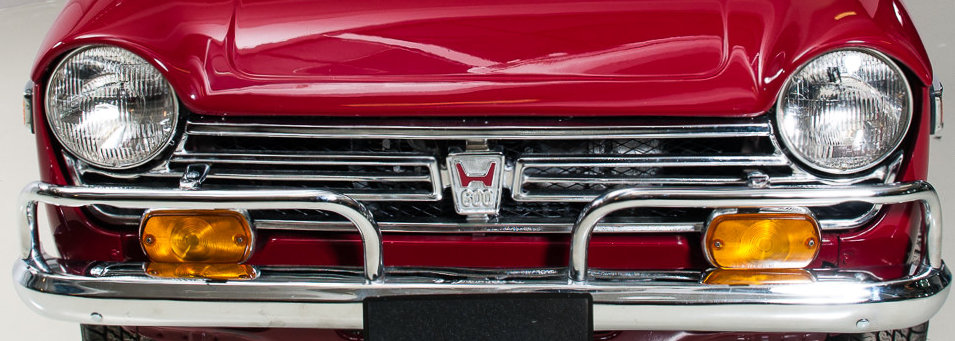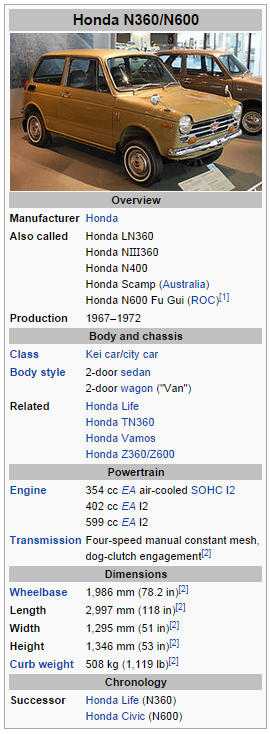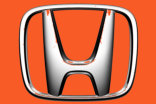




The N600 was called the Fu Gui, meaning 'Wealth' in Chinese

Honda N600 - 1970
The Honda N360 is a kei car, designed and built by Honda
and produced from March 1967 through 1970, while the
larger N600 was marketed through 1973. After a January
1970 facelift, the N360 became the NIII360 and continued
in production until 1972.
The car featured front wheel drive and an air-cooled, four stroke, 354 cc, 31 hp (23 kW) two- cylinder engine, which was borrowed from the Honda CB450 motorcycle. The displacement was reduced so as to comply with kei car legislation which stipulated maximum allowable engine displacement. This same engine was also used in the Honda Vamos, with a beam axle/leaf spring rear suspension. The "N" prefix stands for the Japanese word "norimono" which means "vehicle" in English. The exterior dimensions were in compliance with Japanese government regulations concerning kei cars, however, vehicles installed with the 402 cc and 599 cc engines were too large for the category, and were largely intended for international sales. A modern revival was introduced in 2012 with the Honda N-One.Versions
A two-door sedan was the original body style, with a two-door wagon (considered a commercial vehicle in Japan, and therefore called a "Van") called the LN360 coming in June of the first year. It was an all new, clean-sheet product, and did not share its chassis with the Honda Sports roadster, or the Honda L700 commercial platform. An upgraded 36 hp (27 kW) engine was added in October 1968 for the N360 T. A 402 cc engine was used in the similar N400. The engine's technological specifications reflected engineering efforts resulting from the development of the larger Honda 1300, which used an air-cooled 1.3 litre engine. One of the primary differences between the N360 and the Honda Life that followed was the N360/600 had an air-cooled engine, and the Life had a water-cooled engine. The water-cooled engine was better able to comply with newly enacted emission standards in Japan, and a move away from air-cooled, and two- stroke engines. As does the original Mini, but unlike the succeeding Life, the N360/600 had its gearbox mounted in the sump rather than bolted on as a separate unit. The Hondamatic-equipped N360AT which appeared in August 1968 was the first kei car equipped with an automatic transmission.N600
The larger-engined N600 was developed alongside the N360 in order to target export markets like the US and Europe, where motorways demanded higher top speeds. Just seven months after road testing the N360, Britain’s Motor magazine tested a Honda N600 in November 1968. They reported that it had a top speed of 77.1 mph (124.1 km/h) and could accelerate from 0-60 mph (97 km/h) in 19 seconds. An overall fuel consumption of 36.3 miles per imperial gallon (7.8 L/100 km; 30.2 mpg-US) was achieved. The test car was priced in the UK at £589 including taxes, at a time when the Mini 850 was retailing for £561. The testers were impressed to find 1100 performance from a 600 cc car, but found it ‘very noisy when extended’. They found the Honda as easy to drive and park, and ‘quite well equipped’. The performance figures put the car at or near the top of its class under most criteria, reflecting its favourable power-to-weight ratio. The car was thus 5 mph (8.0 km/h) faster than the 72 mph (116 km/h) achieved by rival magazine Autocar in an N360 in May 1968, and more than ten seconds quicker to 60 mph (97 km/h) which the N360 achieved in 29.3 seconds. Consistent with its slower performance, the N360 squeezed 3 extra miles out of a (UK) gallon of fuel, managing an overall 39.4 miles per imperial gallon (7.17 L/100 km; 32.8 mpg-US). The N600 was introduced to the USA in 1969 as a 1970 model, and was the first Honda automobile to be officially imported to the United States. It was technologically advanced for its time, with an all alloy engine that could achieve 9000 rpm. Engine output was 36–45 hp (27–34 kW) and the N600 was capable of 81 mph (130 km/h). The lower-powered engine arrived in 1972; with milder cams and lowered compression it gave up some peak power and torque, while allowing for a less peaky delivery and higher drivability. It delivered surprisingly peppy performance because of its light weight (around 550 kg/1100 pounds), due to compact dimensions and some plastic parts (like the boot lid). The first brakes were very weak, despite having front discs and servo assistance. Rear suspension was a dead axle on leaf springs. The N600 (along with the TN360 trucklet), were the first Honda cars to be assembled outside of Japan, with production in Taiwan by local joint venture Sanyang Industrial beginning in 1969. The N600 was called the Fu Gui, meaning 'Wealth' in Chinese. US sales stopped in 1972, as for the sportier Honda Z600 (or Z, depending on country), after about 25,000 had been sold there. The first generation Honda Civic replaced these little cars with something a little more suited to the American Interstate system.
1970
Engine 599 cc 2 cylinders Top speed 124 km/h Lenght/width 2,99 m/1,29 m Weight 508 kg
Photos mainly by Matti Kreivilä. Historical facts and technical details of the vehicles provided by Wikipedia. Movies YouTube.



- Autobianchi Transformable - 1960
- Autobianchi Familiare - 1962
- Autobianchi Panoramica - 1962
- Autobianchi Cabriolet - 1963
- BMW Isetta 300 - 1956
- BMW Isetta 300 - 1959
- BMW Isetta Standard
- BMW 600 - 1959
- Bond Bug ES 700 - 1973
- Fiat Topolino - 1936
- Fiat Topolino - 1939
- Fiat Topolino - 1951
- Fiat Belvedere - 1952
- Fiat Topolino - 1954
- Fiat 600 - 1955
- Fiat 500 - 1963
- Fiat 500 - 1969
- Fiat Multipla - 1965
- Fuldamobil 4-wheel - 1958
- Fuldamobil King S7 - 1959
- GLAS Isar T700 - 1962
- Goggomobil T400 - 1959
- Goggomobil T250 - 1961
- Goggomobil T250 - 1969
- Goggomobil Coupe
- Heinkel Kabine - 1959
- Honda N600 - 1970
- Jalta Saporoshez - 1967
- Lloyd Alexander TS - 1960
- Messerschmitt KR200 - 1960
- Messerschmitt KR201
- Messerschmitt KR200 - 1963
- Messerschmitt KR200 - 1964
- NSU Prinz I - 1958
- Scootacar Mk3 - 1963
- Steyr-Puch 500 -1961
- Steyr-Puch 650 - 1964
- Trabant P 50 - 1961
- Trojan 603/198 - 1964
- Trojan 3-wheeler - 1964
- Trojan 3-wheeler - 1964
- Vespa 400 - 1959
- Victoria Spatz 250 - 1957
- ZŁndapp Janus - 1959


- About Scooters
- Apollo moped
- Cezeta 175 - 1960
- Heinkel Tourist - 1960
- Lambretta 125 - 1953
- Puch SR 150 - 1958
- Pyrkijš moped
- Suzuki Burgman 400
- Tunturi City - 1980
- Vespa 150 - 1959
- Yamaha Passola 50 - 1980
- ZŁndapp Bella w. sidecar - 1960
- ZŁndapp Bella 204 - 1960
- ZŁndapp Bella 200 Deluxe - 1963
- ZŁndapp Combinette



















